《固体物理学》课程教学课件(PPT讲稿)Chapter 5 band theory 5.6 Density of states(DOS)and Fermi surface 5.7 the electrons in the crystal 5.8 the experimental results for DOS
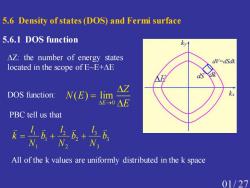
5.6 Density of states (DOS)and Fermi surface 5.6.1 DOS function AZ:the number of energy states dV-dSdk located in the scope of E~E+AE d △Z DOS function: N(E)=li kx E0△E PBC tell us that N N, All of the k values are uniformly distributed in the k space 01/27
5.6 Density of states (DOS) and Fermi surface 5.6.1 DOS function Z: the number of energy states located in the scope of E~E+E DOS function: 0 ( ) limE Z N E → E = E 3 3 3 2 2 2 1 1 1 b N l b N l b N l k = + + PBC tell us that All of the k values are uniformly distributed in the k space
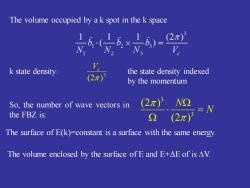
The volume occupied by a k spot in the k space 1) (2π) k state density: the state density indexed 2π by the momentum So,the number of wave vectors in (2x)3N2 =N the FBZ is: Ω (2π)月 The surface of E(k)=constant is a surface with the same energy. The volume enclosed by the surface of E and E+AE of is AV
3 (2 ) Vc N N = 3 3 (2 ) (2 ) The volume occupied by a k spot in the k space k state density: So, the number of wave vectors in the FBZ is: the state density indexed by the momentum The surface of E(k)=constant is a surface with the same energy. The volume enclosed by the surface of E and E+ΔE of is V
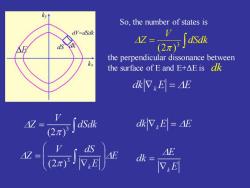
k So,the number of states is dV=dSdk V ds the perpendicular dissonance between the surface of E and E+AE is dk dkVE=AE (2π) dSdk dkV,E=AB
= dSdk V Z 3 (2 ) the perpendicular dissonance between the surface of E and E+ΔE is dk So, the number of states is

So,DOS function: Considering the spin of electrons N-2 a)For free electrons 0= h2k2 2m In the k space,the energy of spherical surface with the radius=2mE/ is equivalent
3 ( ) 2 (2 ) k V dS N E E = = E V dS N E k 3 (2 ) ( ) Considering the spin of electrons So, DOS function: a) For free electrons In the k space, the energy of spherical surface with the radius is equivalent
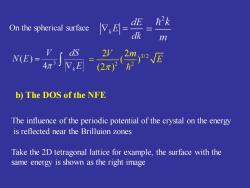
On the spherical surface ,小要的 m M两学”E b)The DOS of the NFE The influence of the periodic potential of the crystal on the energy is reflected near the Brilluion zones Take the 2D tetragonal lattice for example,the surface with the same energy is shown as the right image
On the spherical surface 3/ 2 2 2 2 2( ) (2 ) V m E = b) The DOS of the NFE The influence of the periodic potential of the crystal on the energy is reflected near the Brilluion zones Take the 2D tetragonal lattice for example, the surface with the same energy is shown as the right image
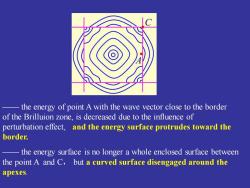
the energy of point A with the wave vector close to the border of the Brilluion zone,is decreased due to the influence of perturbation effect,and the energy surface protrudes toward the border. the energy surface is no longer a whole enclosed surface between the point A and C,but a curved surface disengaged around the apexes
—— the energy of point A with the wave vector close to the border of the Brilluion zone, is decreased due to the influence of perturbation effect, and the energy surface protrudes toward the border. —— the energy surface is no longer a whole enclosed surface between the point A and C, but a curved surface disengaged around the apexes
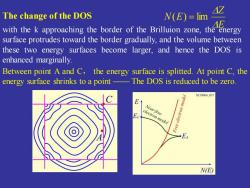
亿 The change of the DOS N(E)=lim E with the k approaching the border of the Brilluion zone,the energy surface protrudes toward the border gradually,and the volume between these two energy surfaces become larger,and hence the DOS is enhanced marginally. Between point A and C,the energy surface is splitted.At point C,the energy surface shrinks to a point -The DOS is reduced to be zero XCH004037 E↑ Near-free electron model EA N(E)
The change of the DOS with the k approaching the border of the Brilluion zone, the energy surface protrudes toward the border gradually, and the volume between these two energy surfaces become larger, and hence the DOS is enhanced marginally. Between point A and C, the energy surface is splitted. At point C, the energy surface shrinks to a point —— The DOS is reduced to be zero. E Z N E ( ) = lim

The DOS in the second Brilluion zone when E surpasses the pint A in FBZ,the DOS will rapidly increase from zero. E↑ EA EA Band Without overlapping overlappiing Ec>E8 N(E) Ec<EB N(E)
The DOS in the second Brilluion zone —— when E surpasses the pint A in FBZ, the DOS will rapidly increase from zero
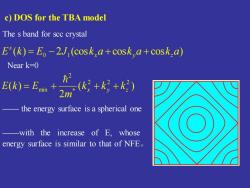
c)DOS for the TBA model The s band for scc crystal E*(k)=Eo-2J(cosk,a+cosk a+cosk.a) Near k=0 E6)=Etk+k+) the energy surface is a spherical one with the increase of E,whose energy surface is similar to that of NFE
c) DOS for the TBA model The s band for scc crystal —— the energy surface is a spherical one Near k=0 ( ) 2 (cos cos cos ) E k E0 J1 kx a ky a kz a s = − + + ( ) 2 ( ) 2 2 2 * 2 min x y z k k k m E k = E + + + ——with the increase of E, whose energy surface is similar to that of NFE
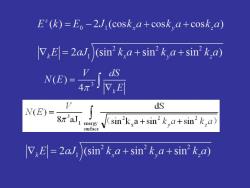
E()=E。-2J(cosk,a+cosk,a+cosk,a) E=2a/)sin2k,a+sin2k,a+sin2k.a) 司 dS N(E)= 、 1 energy sin'ka+sin'k,a+sin2ka) surface =2a )(sin'k,a+sin'k,a+sin'k.a)
按次数下载不扣除下载券;
注册用户24小时内重复下载只扣除一次;
顺序:VIP每日次数-->可用次数-->下载券;
- 《固体物理学》课程教学课件(PPT讲稿)Chapter 7 The electronic theory of metal 7.1 Fermi statistics and the heat capacity of electron 7.2 Work function and contact potential.ppt
- 《固体物理学》课程教学课件(PPT讲稿)Chapter 7 The electronic theory of metal(supplement - Sommerfield expansion).ppt
- 《固体物理学》课程教学课件(PPT讲稿)Chapter 6 Electron motion in the crystal 6.4 The electron motion in a constant electric field 6.5 Band structure of conductor, insulator and semiconductor.ppt
- 《固体物理学》课程教学课件(PPT讲稿)Chapter 6 Electron motion in the crystal 6(supplement - a more concise description of quasi-momentum).ppt
- 《固体物理学》课程教学课件(PPT讲稿)Chapter 6 Electron motion in the crystal 6.1 The quasi-classical description of Bloch electrons 6.2. Electron quasi-momentum 6.3 The accelerated velocity and effective mass.ppt
- 《固体物理学》课程教学课件(PPT讲稿)Chapter 5 band theory 5.4 Tight Binding Approximation(TBA).ppt
- 《固体物理学》课程教学课件(PPT讲稿)Chapter 5 band theory 5.3 Nearly Free Electron 5.4 BZ and energy bands.ppt
- 《固体物理学》课程教学课件(PPT讲稿)Chapter 5 band theory 5.5 The symmetry of bands.ppt
- 《固体物理学》课程教学课件(PPT讲稿)Chapter 4 lattice dynamics and lattice capacity 4(supplement - Thermal Expansion of Glass).ppt
- 《固体物理学》课程教学课件(PPT讲稿)Chapter 4 lattice dynamics and lattice capacity 4.6 Anharmonic Effects 4.7 Equation of states for Lattice 4.8 Experimental methods for the determinations of lattice vibration spectroscopy.ppt
- 《固体物理学》课程教学课件(PPT讲稿)Chapter 5 band theory 5.1 general background and approximations 5.2 Bloch’s Theorem.ppt
- 《固体物理学》课程教学课件(PPT讲稿)Chapter 4 lattice dynamics and lattice capacity 4.5 Heat capacity of the lattice.ppt
- 《固体物理学》课程教学课件(PPT讲稿)Chapter 4 lattice dynamics and lattice capacity 4.1 Normal Modes of Vibration 4.2 Density of States 4.3 Harmonic approximation and normal mode coordinates 4.4 phonon.ppt
- 《固体物理学》课程教学课件(PPT讲稿)Chapter 3 Interatomic Bonding 3.1 General crystal binding 3.2 typical binding.ppt
- 《固体物理学》课程教学课件(PPT讲稿)Chapter 3 Interatomic Bonding 3(Supplement - Rules of crystal binding).ppt
- 《固体物理学》课程教学课件(PPT讲稿)Chapter 3 Interatomic Bonding 3.3 The cohesive energy for ionic crystal.ppt
- 《固体物理学》课程教学课件(PPT讲稿)Chapter 2 Wave Diffraction & the Reciprocal Lattice(2.1-2.5).ppt
- 《固体物理学》课程教学课件(PPT讲稿)Chapter 2 Wave Diffraction & the Reciprocal Lattice 2.6 X-Ray Diffraction Methods 2.7 Applications of XRD.ppt
- 《固体物理学》课程教学课件(PPT讲稿)Chapter 2 Wave Diffraction & the Reciprocal Lattice(supplement - Review & Overview of X-Rays).ppt
- 《固体物理学》课程教学课件(PPT讲稿)Chapter 1 Crystal Structure 1.9 Elements of Symmetry 1.10 Space groups 1.11 7 crystal system and 14 Bravis Lattice.ppt
- 《近代物理实验》课程教学大纲.doc
- 《近代物理实验》课程教学资源(PPT课件讲稿,共五部分).ppt
- 《工程光学》课程教学大纲 Engineering Optics.doc
- 安徽大学:《工程光学》课程授课教案(讲义,共十三章,授课教师:李桂华).doc
- 《工程光学》课程实验指导书(共六个实验).doc
- 《量子力学》课程教学课件(讲稿)Chapter 4 态和力学量的表象 The representation for the states and dynamical variable.pdf
- 《量子力学》课程教学课件(讲稿)Chapter 1 绪论 Quantum mechanism(量子力学的诞生).pdf
- 《量子力学》课程教学课件(讲稿)Chapter 2 波函数和薛定谔方程 The wave function and Schrödinger Equation.pdf
- 《量子力学》课程教学课件(讲稿)Chapter 3 量子力学中的力学量 The Dynamical variable in Quantum Mechanism.pdf
- 《量子力学》课程教学课件(讲稿)Chapter 6 散射 Scattering.pdf
- 《量子力学》课程教学课件(讲稿)Chapter 5 微扰理论近似方法 Approximation(本征值问题的似解).pdf
- 《量子力学》课程教学课件(讲稿)Chapter 7 自旋与角动量、全同粒子体系 Spin and undistinguished similar particles.pdf
- 《量子力学》课程教学资源(习题解答)第七章 自旋与角动量、全同粒子体系.doc
- 《量子力学》课程教学资源(习题解答)第三章 量子力学中的力学量.doc
- 《量子力学》课程教学资源(习题解答)第二章 波函数和薛定谔方程.doc
- 《量子力学》课程教学资源(习题解答)第五章 微扰理论.doc
- 《量子力学》课程教学资源(习题解答)第四章 态和力学量的表象.doc
- 《量子力学》课程考试大纲(自考).doc
- 《量子力学》课程教学资源(习题解答)第一章 量子理论基础.doc
- 《量子力学》课程教学资源(习题解答)第6章 碰撞理论.doc
